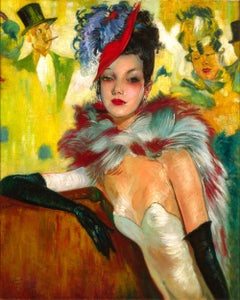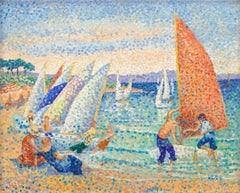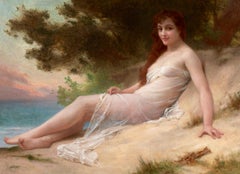Jean-Pierre CassigneulLe Soir by Jean-Pierre Cassigneulcirca 1975
circa 1975
About the Item
Born in Paris in 1935, Cassigneul studied at the Ecole des Beaux-Arts, holding his first one-man exhibition at the young age of 17. Since that first show, his work has been widely exhibited throughout the world, particularly in Western Europe, the United States, and Japan, where he enjoys an especially devoted following. This work is pictured on page 12 of Cassignuel et La Mer, 1993, by K. Shoin Circa 1975 Canvas: 18” high x 24” wide Frame: 25 5/8" high x 31 5/8" wide References: Cassignuel et La Mer, 1993, K. Shoin
- Creator:Jean-Pierre Cassigneul (1935, French)
- Creation Year:circa 1975
- Period:
- Condition:
- Gallery Location:New Orleans, LA
- Reference Number:Seller: 30-32891stDibs: LU186397742
Jean-Pierre Cassigneul
Jean-Pierre Cassigneul is a French painter known for his serene portraits of women in hats that recall the French Post-Impressionist avant-garde, including the works of Pierre Bonnard and Edouard Vuillard.
Cassigneul was born on July 13, 1935, in Paris. He studied at the École des Beaux-Arts in Paris and went on to exhibit in various group exhibitions, including the Salon d'Automne in Paris (of which he was member), the Salon de la Jeune Peinture and more. Cassigneul exhibited at the Beaubourg Center in Paris in 1977 and solo as of 1952, on a regular basis in France but also in New York, and Tokyo and worldwide.
Cassigneul is known for his charming and extremely popular Van Dongen–influenced paintings of women in floral hats, complete with frequent allusions to other aspects of the Années Folles. His first solo exhibition was at the Galerie Lucy Kroge in Paris when he was 17 years old.
Find a collection of Jean-Pierre Cassigneul prints on 1stDibs.
(Biography provided by Joseph Grossman Fine Art)
You May Also Like
2010s Abstract Paintings
Mixed Media
2010s Abstract Abstract Paintings
Mixed Media
21st Century and Contemporary Contemporary Figurative Paintings
Canvas, Acrylic
21st Century and Contemporary Contemporary Figurative Paintings
Canvas, Acrylic
Ayotunde AyomideGaze 2 - Contemporary, 21st Century, Contemporary, Figurative, Portrait, Women, 2024
21st Century and Contemporary Contemporary Figurative Paintings
Canvas, Acrylic
2010s Street Art Portrait Paintings
Canvas, Ink, Mixed Media, Acrylic
2010s Street Art Portrait Paintings
Canvas, Ink, Mixed Media, Oil
2010s Street Art Portrait Paintings
Canvas, Ink, Mixed Media, Oil
1930s Modern Figurative Paintings
Oil
2010s Street Art Portrait Paintings
Canvas, Ink, Mixed Media, Oil
More From This Seller
View All20th Century Post-Impressionist Figurative Paintings
Canvas, Oil
20th Century Post-Impressionist Landscape Paintings
Canvas, Oil
19th Century Academic Nude Paintings
Canvas, Oil
20th Century Other Art Style Figurative Paintings
Canvas, Oil
19th Century Qing Paintings
Glass, Oil
18th Century Portrait Paintings
Canvas, Oil
Still Thinking About These?
All Recently ViewedRead More
Paul Revere Crafted This Silver Coffee Pot 250 Years Ago
Perhaps best known as a Revolutionary War hero, Revere was also an accomplished silversmith, and this pot is now available on 1stDibs.
Degas Portrayed These Exuberant Ukrainian Dancers with ‘Orgies of Color’
Discovered in Parisian cabarets, the performers reenergized the artist’s practice.



